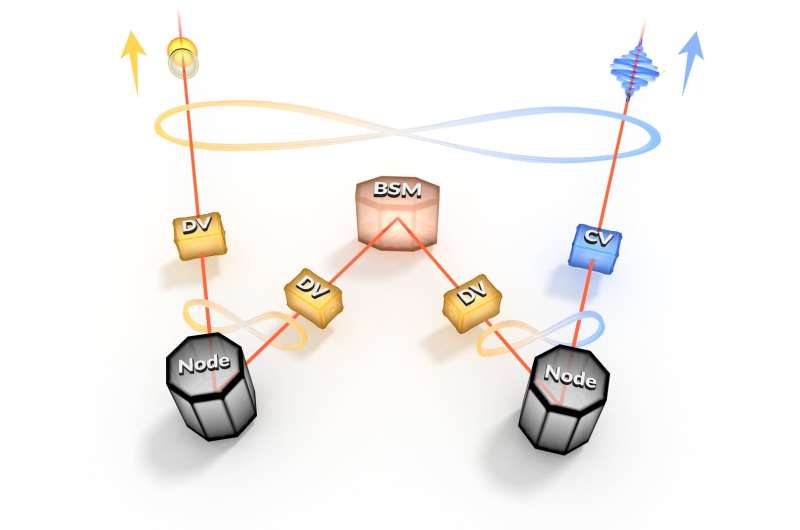A heterogeneous quantum networks linked by entanglement swapping. This process enables the connection of disparate physical platforms at longer distances and the conversion of quantum information from one encoding to another. Credit: Laboratoire Kastler Brossel
Researchers at the Kastler Brossel Laboratory in Paris have succeeded in implementing a novel "hybrid" entanglement swapping protocol, bringing within reach the connection of disparate platforms in a future, heterogeneously structured, quantum internet.
In the May 29th online issue of Science Advances, Prof. Julien Laurat and his colleagues at LKB (Sorbonne Université, CNRS, ENS-Université PSL, Collège de France), with collaborators at NIST Boulder, have announced an important step toward the development of heterogeneous quantum networks. The team has demonstrated a way of connecting different types of quantum nodes that are not necessarily based on the same type of encoding. Enabling such a type of link is a crucial requirement for the interconnection of different physical platforms that can perform dedicated quantum-enhanced tasks.
Quantum networks are composed of quantum systems located at distant nodes and connected via non-classical correlations known as entanglement—the "spooky action at a distance." They are believed to outperform current classical networks in tasks ranging from quantum-secure communication to enhanced measurements. Similarly to classical networks, where information can be encoded in two distinct digital or analog encodings depending on the tasks at hand, quantum networks can rely on two types of encodings, as exemplified by the particle-wave duality. On the one hand, side one can favor the particle nature of the quantum bits (or qubits) in an encoding similar to the digital one, and referred to as "discrete-variable." On the other hand, one might prefer using the "continuous-variable," analog-like, encoding which spurs from the wavy nature of the particles—a well-known consequence of quantum mechanics.
In quantum networks, the connection of distant nodes is performed by a specific operation called entanglement swapping. This procedure allows to connect systems that have never interacted before by using a specialized measurement between two other resources separately entangled with the systems involved. This operation, known as Bell-state measurement, effectively transfers—or "teleports"—the entanglement to the final systems. However, because of the fragility of the entanglement, implementing a protocol so central to the establishment of quantum connections is a real challenge for physicists. To achieve the transfer of entanglement and the connection between different types of nodes, two highly entangled states need to be produced—in particular one "hybrid-entangled" state between particle-like and wave-like qubits. The team at LKB has successfully propagated, from these two sources, entanglement between different states of light that never directly interacted.
"This work is a stepping stone for further investigations into the implementation of heterogeneous quantum networks," says Tom Darras, a graduate student at LKB and one of the leading authors of the paper. "So far, two communities were developing quantum communication using different routes. Now that the bridge has been built, we expect to see, by using the advantages of each branch, the emergence of novel hybrid scenarios going much further than current developments."
The two optical entangled states involved in the experiment are engineered using optical parametric oscillators, which are efficient non-linear sources. One entangled state is obtained by "splitting" a single photon between two different paths, without knowing which path is followed. The other is a "hybrid-entangled" state between a discrete-variable optical qubit and a continuous-variable Schrödinger cat optical qubit—referring to Schrödinger's Gekanden experiment coupling a macroscopic object to a quantum system. Once entanglement is generated through a heralding process, it is then swapped via a unique hybrid Bell-state measurement. The authors have accomplished every step of this demonstration, from creating the initial entangled states to fully characterizing the entanglement after the swapping operation.
"The full team expertise in engineering entanglement, coupled to state-of-the-art tools for quantum state generation and characterization, was instrumental to the success of the protocol" adds Giovanni Guccione, a Marie Curie postdoctoral fellow who is also one of the leading authors of the study.
Additionally to the creation of a link between disparate users, the experiment is a key step toward the building of scalable networks. "Entanglement is an inherently fragile resource which means its distribution over larger distances represents a significant challenge" notes Adrien Cavaillès, postdoctoral fellow and corresponding author of the paper. "As it extends the accessible range of distribution, the entanglement swapping protocol performed by the group is a crucial capability for future large-scale hybrid quantum networks."
The work reported in Science Advances is a major achievement toward the interconnection of different physical platforms. However, the researchers also emphasize that "even though the ability to connect quantum nodes of different nature is now at hand, the connection is for the moment only limited to optical systems, and needs to be extended to many other physical platforms." A fully functional heterogeneous quantum networks still requires significant progress in the engineering and transfer of entanglement between different matter systems.
This demonstration builds upon the previous advances in Prof. Laurat's group in the recent years, from the first demonstration of hybrid entanglement between particle-like and wave-like qubits to the engineering of hybrid states and their use in quantum information protocols, either for remote state preparation or security certification.
The other authors are Hanna Le Jeannic, a previous graduate student at LKB, Varun B. Verma and Sae Woo Nam, collaborators at NIST Boulder. This work has been supported by the European Research Council, the French National Research Agency (project Hy-Light), Sorbonne Université and the Région Ile-de-France in the framework of the DIM Sirteq.
The title of the paper is "Connecting Heterogeneous Quantum Networks by Hybrid Entanglement Swapping." It is available in the May 29th online issue of Science Advances.
More information: Giovanni Guccione et al. Connecting heterogeneous quantum networks by hybrid entanglement swapping, Science Advances (2020). DOI: 10.1126/sciadv.aba4508
Journal information: Science Advances
Provided by Sorbonne University
























